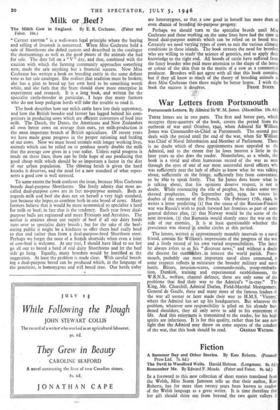Milk or Beef
" CAVEAT EMPTOR" is a well-worn legal principle where the buying and selling of livestock is concerned. When Miss Cochrane held a sale of Shorthorns she defied custom and described in the catalogue the shortcomings as well as the good Points of the animals she had for sale. The date fell on a " V " day, and that, combined with the caution with which the farming community approaches something new, made the sale anything but a financial success. Now Miss Cochrane has written a book on breeding cattle in the same defiant tone as her sale catalogue. She realises _that tradition must be broken; she has a plan to breed up her own herd to be something worth while, and she feels that the State should show more enterprise in experiment and research. It is a long book, and written for the specialist cattle-breeder in particular... I hope that many farmers who do not keep pedigree herds will take the trouble to read it.
The book describes how our milch cattle have lost their supremacy, and how the British breeder and fanner has lagged behind his com- petitors in producing cows which are efficient converters of food into milk. The Dutch, the Danes, the Americans and New Zealanders all own better cows on average than ours, yet milk-production is the most important branch of British agriculture. Of recent years we have made great progress in the proper rationing and feeding of our cows. Now we must breed aniMals with longer working lives, animals which can be relied on to produce nearly double the milk that the average cow gives in a year today. Unless rapid progress is made on these lines there can be little hope of our producing that good cheap milk which should be so important a factor in the diet of our urban population. The slibwing fetish is given the hard knocks it deserves, and the need for a, new standard of what repre- sents a good cow is well stressed.
To some extent the book confuses the issue, because Miss Cochrane breeds dual-purpose Shorthorns. She freely admits that most .so- called dual-purpose cows are in fact no-purpose animals. Both as regards milk and beef she does not set herself a very high standard, just because she hopes4to combine both in one breed of cows. Many farmers believe that it would be more economical to specialise a herd for milk or beef; in fact that is the tendency. Each year fewer dual- purpose bulls are registered and more Friesians and The author is anxious about our supply of beef if all our dairy herds turn over to specialist dairy breeds ; but for the sake of the beef- eating public it might be a kindness to offer them beef really bred to that end rather than from a dual-purpose-bred Shorthorn steer. Perhaps we forget the taste of a Scotch shortside when even a joint of cow-beef is welcome. At any rate, I should have liked to see her go all out to breed a herd of real dairy Shorthorns and let the beef side go hang. Equally, many breeders would be horrified at the suggestion. At least the problem is made clear. With careful breed- ing a dual-purpose breed can be produced which, in the language of the geneticist, is homozygous and will breed true. Our herds today
are heterozygous, so that a cow good in herself has more than an even chance of breeding no-purpose- progeny.
Perhaps we should 'turn to the specialist breeds until Miss Cochrane and those working on the same lines have had the time to breed dual-purpose animals which can be relied on to breed true, Certainly we need varyinrtypes of cows to suit the various climatic conditions in these islands. The book stresses the need for breeders who are willing to study'the science of genetics, and to apply their knowledge to the right end. All breeds of cattle have suffered from the fancy breeder who paid more attention to the shape of the horns or colour of the skin than to the merits of a cow as a commercial producer. Breeders will -not agree with all that this book contain; but if they all knew as much of the theory of breeding animals as does Miss Cochrane then there might be better hopes. I wish the


























 Previous page
Previous page